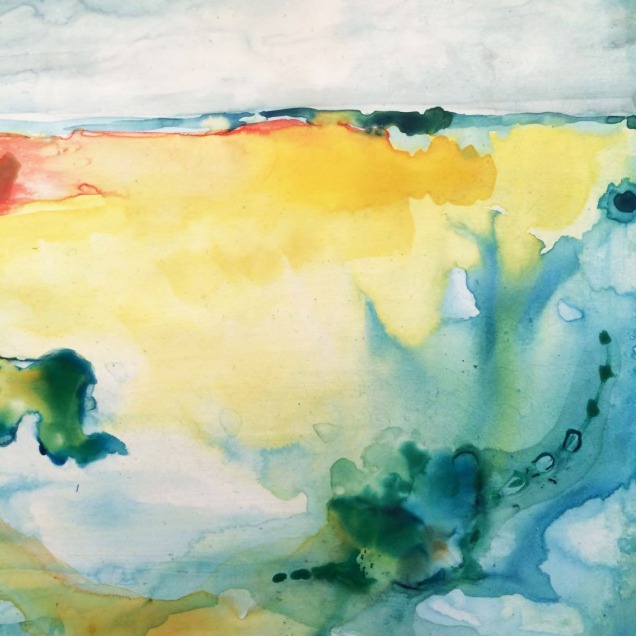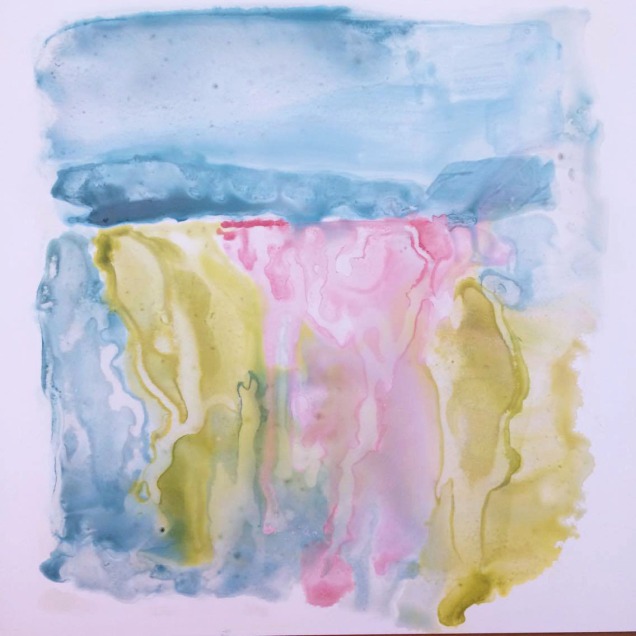Having spent a bit of time finding out how different mediums behave in this post, I wanted to see how claybord would suit my purpose in creating an abstract landscape.
I had a vague idea around creating some translucent loose abstract landscapes – and because of this ruled out oil paints. Really, I wanted to try watercolour or very thin acrylic.
Here’s the first:

In parts of this painting I used gum arabic to even the flow of pigment – the pooling is pretty but getting an even wash is a challenge I think. In other parts I used neat vodka to create blooms and movement, as well as tilting and turning the claybord. Not cheap stuff either, but now we’re not thirty anymore, we just don’t drink it, so it’s been sitting around for many years ( I also use it for wetting in pastel underpaintings – it works great!).
I really didn’t like this when I painted it, so wiped it…..now I wish I hadn’t as there’s quite a bit I do like about it now – the colours, the movement, the darker marks of paint bottom right.
I also tried thinned down acrylic (flow release, water and air brush medium):

I began to fiddle a bit with this, so sprayed the whole thing and gave it a swirl. I might go back to this and add either additional thin layers or see what opaque marks I can make without loosing some of this early layer.
In conclusion, Claybord is an interesting support to work on, though I suspect it comes into it’s own for very detailed, carefully controlled and not too wet techniques. The beauty of it is how much easier it is to lift out highlights. It also takes pen and ink, and graphite.
Trying to create something in between, e.g. a loose and splashy abstract landscape is perhaps asking too much me, rather than the claybord!

Love your experiments! I did order some of this, and wondering how it will be with a brush and acrylic paint. I may have to put molding paste on it first to keep it from being too slippy, I guess? I really prefer the watercolor to the acrylic – and surprised by this!
LikeLiked by 1 person
I guess you could put anything on it: gesso, masking fluid, paste. I have three 8 x 8 panels. I have no idea what to do with them! Other than splodge watercolour about – I love the watercolour effects too, so lovely to watch the paint move around! Can’t wait to see what you do with yours!
LikeLiked by 1 person
Thanks, Vicki! Do you think it would work, acrylic direct to the board with a brush? Would it just slide right off? I’m still so new to acrylics, only worked on canvas and canvas paper so far.
LikeLiked by 1 person
I used it directly onto the claybord, both thin (like watercolour) and thick (like how I’d normally paint with acrylics) – it does go on either way, but I recommend you start thin, let the layers dry and build up with thicker paint – if that’s what you want! I bought some “spare” claybord so I could practice and mess around seeing how different mediums behaved, rather than going straight in to a finished painting. I don’t think my style lends itself to claybord as I tend to paint quite loose, but I have seen amazing things done with it – you tube have some info and inspiration! Good luck!
LikeLiked by 1 person
Thanks so much for that suggestion! When you say “spare”, do you mean scrap pieces? If so, that was a terrific way to go about it.
LikeLiked by 1 person
Ha, no, I mean I purchased extra!
LikeLiked by 1 person
oh, gotcha lol. Would be nice if we could buy scrap pieces of all different surfaces! 🙂
LikeLiked by 1 person
Thanks for sharing your experiments and information!
LikeLiked by 1 person
Hi Susan! You’re welcome, have a lovely weekend.
LikeLiked by 1 person
Enjoy your weekend too Vicki!
LikeLike
melting soft merging edges!! love it!
LikeLike
I LOVE the watercolor!!!
LikeLiked by 1 person
Me too Bonnie, thank you!
LikeLike